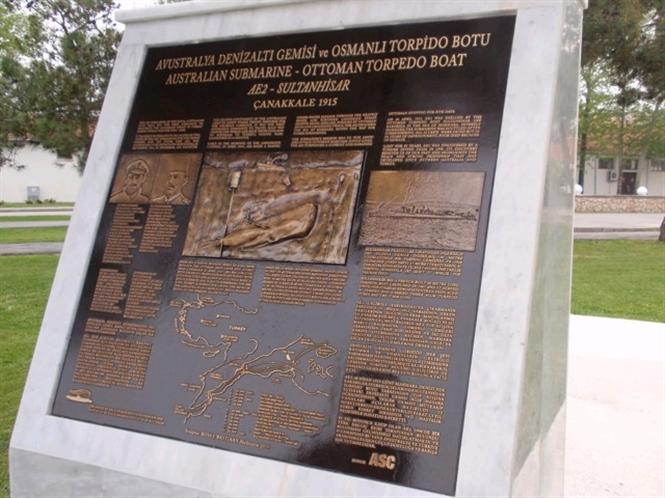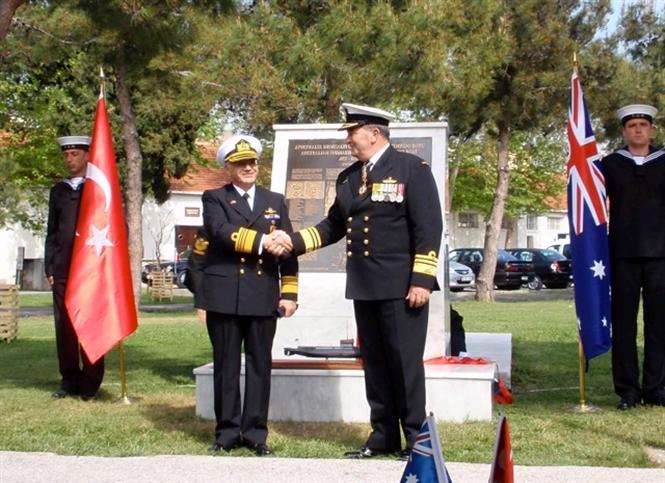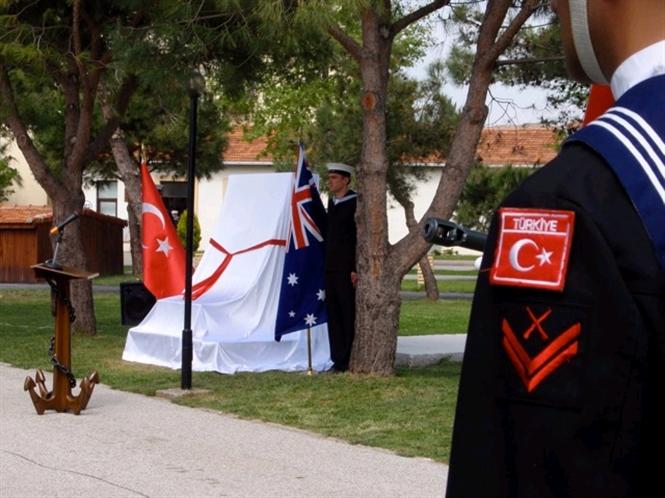The AE2 - SULTANHISAR Memorial
Description
A bronze plaque mounted on a marble plinth with a glass display case on a shelf at the front to display models of the AE2 and the Sultanhisar.
History
In 1907, Alfred Deakin, the Prime Minister of Australia, returned from a conference in London convinced the submarine was not only a potent weapon but also one that was suitable for Australia. Proposing to buy three a year for three years, Deakin’s idea was shelved by his successor, Andrew Fisher. In 1909, with the growth of the German Navy causing increasing concern, the Admiralty proposed three small ‘C’ class submarines as part of an Australian Fleet, later deciding that two of the much larger ‘E’ class submarines would be better suited. HMAS AE1 (A for Australia) and HMAS AE2 were commissioned on 28 February 1914.
On the outbreak of the First World War, the AE1 and the AE2 joined naval forces in the Pacific. On 14 September 1914, the AE1 was lost with all hands, off Rabaul, in mysterious circumstances. On 31 December the AE2, having returned to Australia, sailed to Suez as the sole escort of the 2nd Convoy of AIF troops.
On 25 April 1915, with a crew of 32 Australians and British and commanded by Lieutenant-Commander H H G (Dacre) Stoker, the AE2, also known as the ‘Silent Anzac’, was the first Allied submarine to penetrate the Dardanelles Strait. Her mission: to ‘generally run amok’ around Çannakale to create a diversion from the Anzac landings on the Gallipoli peninsula then enter the Turkish inland Sea of Marmara to cut the supply lines of the Ottoman army. Her eventful voyage through the Narrows, notorious for its sharp bends and swift and unpredictable currents, was made more hazardous by having to negotiate enemy mines. Also, in those days submarines had to surface frequently to take accurate course bearings from nearby landmarks and, at times, run on the surface under diesel power in order to recharge the batteries. Against all odds, the AE2 succeeded. The news of the her success had a dramatic effect in lifting the morale of the Allied forces and rousing the optimism of the commanding officers. Stoker and his crew had paved the way for other E-class submarines of the Royal Navy to attempt the Dardanelles.
Between 26 and 30 April, the AE2 hunted for Turkish ships in the southern area of the Sea of Marmara. While having little success in sinking anything, the psychological effect of her presence and the disruption caused to the Turks was considerable.
The AE2’s campaign ended on 30 April 1915. In an engagement with the Turkish torpedo-boat SULTANHISAR, the engine room was hit and holed in three places. Stoker, determined not to let his submarine fall into enemy hands, ordered that the AE2 be scuttled. All the tanks were opened to flood her and, at 10.45 am, she slid to the bottom of the sea. She had been in commission almost fourteen months.
Stoker and his crew were rescued by the SULTANHISAR and began three and a half years of captivity in Turkish prisoner-of-war camps. Four crew members did not survive the rigors of captivity. The AE2 lay in the Sea of Marmara, unseen, until 1998 when she was located, intact, some 73 metres underwater.
Construction Information
The plaque was arranged by Dr Ross Bastiaan in conjunction with the site sponsor, Australian Maritime Services Ltd (AMS).
Location
Cimenlik Sk, Canakkale, Turkey.
The memorial is located at the Turkish Navy Museum in Cimenlik Park. From Canakkale Feribot Iskelesi (ferry terminal) head south on Cumhuriyet Blv/E87 towards Balikhane Sk then turn right onto Yali Cd and continue to the end.


